The Intercepts Theme
The intercepts theme is the simplest theme in the game from a design point of view. The reason for this is that placing intercepts is, at least compared to other themes, technically easy to implement. Although stacking periodic enemies is conceptually simple, the designer has to account for the interplay of two heterogeneous periods, and allow a window of time in which the player can move or jump. Thus, the periodic enemies theme can get quite technically difficult for the designer building it, even if the idea behind it is simple. The intercepts theme, on the other hand, isn't about timing; it's about reactions. This fact gives the designer more leeway, and probably made for fairly simple construction. Indeed, the Intercepts theme is one of the geographically simplest themes in the game, as each level will show. Most intercepts levels have as their most geographically complex feature a short section of platforms at alternating heights.

The platforms and jumps themselves are not meant to be difficult; this theme has a medium-sized d-distance and delta-height, but has the largest average platform size for both launching and landing platforms--even larger than those in the preservation of momentum. The whole point of this theme is to get Mario into a situation where he's making a geographically simple jump, and then complicate that jump with intercepts.
What makes this theme easy for the designer but challenging for the player is that levels can become intricate without much iteration. By Vanilla Dome 4, all the types of intercepts have appeared already, and all that remains for the designer is to mix and match them.

Above we have the tracking, linear, overhead, bouncing and swooping/descending intercepts, the mix of which constitutes the bulk of this theme�s content. There are definitely cases where they mix and are not technically accumulations, but they can often feel like them to the player. The most technical definition of an accumulation gives us a challenge in which two elements of a skill theme are overlaid to create enhanced difficulty. The most technical definition of an intercept is an enemy or obstacle which modifies a jump Mario has already taken. These shots are from Vanilla Dome 4 and Butter Bridge 2, respectively. They don�t exactly match the technical definition of an intercept accumulation.

So although in these cases there are only two types of enemies coming at Mario, the shift from pitfall intercepts to layered enemies is one that accomplishes the same thing as an accumulation. It�s an increase in complexity without the introduction of a novel element. In the end, the technical definitions of intercepts and accumulations are only tools to help us systematically understand the game. Sometimes those definitions aren�t going to be as useful as other times, and the intercepts theme shows us why.
There are real accumulations, though, and that is where this theme gets interesting. Cookie Mountain reveals the context of the last key ingredient in intercept accumulations: the ground-based intercept. This isn�t the Monty Mole�s first appearance, but it is his first appearance in quantities and contexts that take advantage of his intercept behaviors.
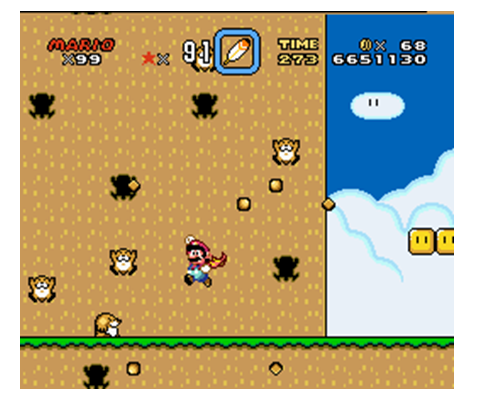
The Monty Mole�s ability to track Mario is the key addition here. Without tracking, there are very few situations in which a ground-based enemy can be an intercept. (Note that although the Chuck is frequent in the early game and will track Mario, he is almost always implemented in an open �arena� setting until the end of this theme. Since that kind of implementation has little to do with reflexes, it has little to do with the intercepts theme by this point in the game.) It only makes sense that mixing and matching intercepts is a lot easier if the designer can also use the ground. Without ground-based intercepts, accumulations would all be like Butter Bridge 2. With them, we have these challenges instead.

Outrageous, naturally, takes the accumulations to a spectacular extreme. Interestingly, on the path toward the pinnacle level of Outrageous, the design team introduces the Dino-Rhino which is the most dangerous ground-based intercept. The lack of the Dino-Rhino is the only noteworthy omission from Outrageous. The problem is that the Dino-Rhino is so dangerous that the designers actually have to abandon it almost immediately after introducing it in Chocolate Island 1. Few challenges after this point involve it at all, and none in a cadence progression. This enemy would have been pretty easy to implement, but any more intercepts and the level would have been too hard. This is another sign that intercepts can be an easy tool for designers to use in platformers, but that their ease of implementation has no relation to the difficulty of a level, and in some cases the two factors can actually correlate inversely.
DONUT PLAINS 2
Donut Plains 2 introduces the intercepts theme by slowing down the pace of the level to a controlled crawl. Most levels in the intercepts theme incline toward a faster pace, but this one does not because the goal of this level is to teach players about the intercepts theme without simply throwing them into it. The central idea in the intercepts theme is to get the player to react, and modify Mario�s run or jump-path. To that end, this level offers three things, the first of which is a set scroll speed that prevents the player from rushing Mario through the challenges. The second and third things that prevent rushing are uneven terrain and the Swooper enemy. Both of these features cause new players to make last-second decisions while moving, which is the foundation of the intercepts� set of reaction skills. The warning shots in this level are fairly obvious: these Buzzy Beetles are not hard because there�s plenty of overhead space to jump.
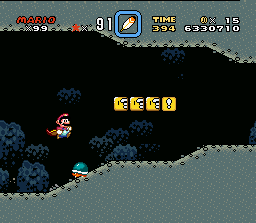
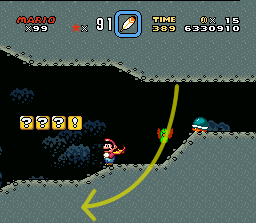
On the other hand, the Swoopers pictured above are not terribly dangerous either, since they�re going to simply fly through the inaccessible regions of the bedrock. The important part is that, as part of a warning shot, it will at least provide fair warning as to the Swooper�s irregular flight path.
There�s a fairly obvious progression in the level that involves putting Mario in the same basic situation over and over again: Beetles followed by Swoopers on top of undulating platforms. Here we can see the first really dangerous encounter with a Swooper.
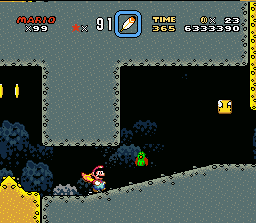
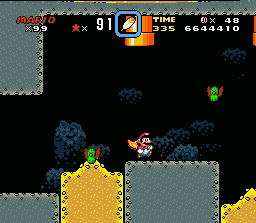
The Swooper�s bending flight path intercepts Mario�s path, but also takes place in a corridor that makes jumping tricky and forces Mario to wait until the last second to take that jump (or use a cape attack). This happens throughout the level, and it makes for a lot of last-second reactions. The second example shown above is an expansion/evolution, as not only are there two Swoopers, but their flight paths will intercept Mario as he�s ascending. Mario�s ascent makes reacting to the Swoopers more difficult, as the player will have to mentally calculate how to best attack the enemy at two different points in its oddly-shaped flight path.
For the third instance of the Swooper�s path, the level uses a mutation upon the previous expansion challenge. These Swoopers are roughly the same height above Mario as in the standard challenge, but this time Mario is descending�whether the player wants to or not, because of the rising and falling platforms.
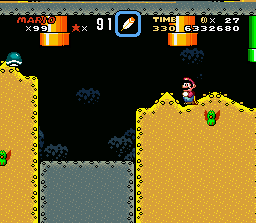
This descent is particularly good about emphasizing the value of the cape-glide, which is a skill brand new to the player at this point in the game. One of the essential skills involved in making the cape-glide work is adjusting Mario�s path mid-flight, which these Swoopers force the player to do. The final challenge featuring the Swoopers sees them crowded into a narrow corridor, just high enough that their arc will intercept Mario�s walking path before they fly off screen. This is an example of the expansion-by-contraction which will appear frequently in this theme.
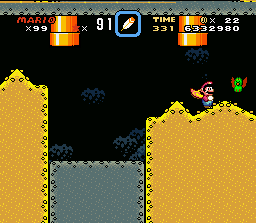
To dial up the difficulty for this challenge, the designers added an A+B evolution element, including the Buzzy Beetle on the ground. The slowness of the level�s scroll speed prevents this from tangling the player up too much, but it at least provides a good chance for the player to synthesize some skills at the end of the level.
During the rest of the level, the Buzzy Beetles have been serving the purpose of teaching the player how to use the cape�s offensive spinning ability. The essential property of these enemies is that they�re immune to fireballs, and so have to be defeated with jumps or other lateral attacks (like the cape). In a level with low ceilings, the lateral attack becomes much easier�but they�re not too easy. The designers made sure that the Beetles mostly appear on uneven ground. Even the most inexperienced players can figure out how to do an ordinary cape-spin on level ground; mastery involves being able to do it when the ground isn�t level, because that involves mixing the jump and the spin in a number of different ways, depending on context. So naturally, Beetle encounters in this level rarely happen on flat planes.
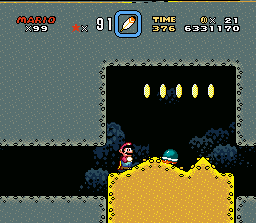
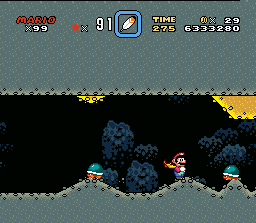
The first encounters are all obvious: the Beetles are coming down the slope, visible from far off, and their path and speed are easy to estimate. On terrain that is more varied like you see above, the player needs to have the right timing to avoid a situation where the enemy is descending and Mario can�t take advantage of the usually easy hitbox most enemies have on their jump-prone tops. Overall, this is a simple level that still manages to be frustrating because of the dragging pace. The designers felt that slow pace was necessary to help players learn about intercepts, and the decision has its merits. Unlike in some of the other skill themes, there�s no obvious way to make a training-wheels challenge out of intercepts. How would it be possible to implement enemies without having them do any damage? Thus, the tedium of this level represents a problem that the designers couldn�t get around without adding extraneous elements to their game, something they have proven time and again that they would not do.
DONUT SECRET 1
This level does many things that the Ghost Houses also do, although it does them more effectively, probably because the designers didn�t have to spend any energy on designing puzzles. In a water level, combat changes significantly because Mario is vulnerable from below. The problems presented by uneven terrain in Donut Plains 2 are magnified here that much more; getting a clear shot on the enemies is more difficult. The primary intercept in this level is the Rip Van Fish, who will follow Mario after he enters the fish�s aggro radius. The Rip Van Fish (hereafter RVF) shares a behavioral property with the Boo: both enemies follow Mario imperfectly. The RVF�s flaw is that it tends to pull up too high and overshoot Mario in that manner. This makes evasion possible, but it also makes combat slightly more difficult for new players who have not yet internalized this property.
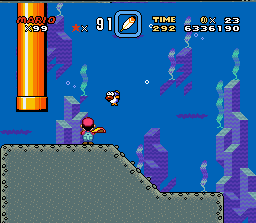
Because players have to either position Mario parallel to a fish (for the cape) or take a specific superior angle for fireballs, the first few encounters with RVFs can be tricky. And this says nothing of whole challenges in the level, which do more than simply throw one RVF at Mario.
There�s probably no better example of a warning shot covering all of a level�s elements than this one right here. The first screen introduces the player to every kind of fish and displays their behaviors.
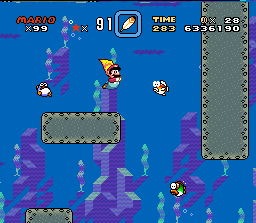
For the rest of the level, the following things will happen: RVFs will seek Mario, Blurps will swim in straight lines, and the white fish will patrol certain spaces. This also highlights just how much the designers accomplished with only three types of enemies: the subsequent challenges provide a decent amount of variety using only what is presented here.
The standard challenge for the level, which you can see below, features an RVF that chases Mario into two other enemies. Now, because of the �pulling up� behavior of the RVF, it will almost certainly overshoot Mario, but new players aren�t going to know this yet, and so they�ll try to quickly shoot down into the gap.
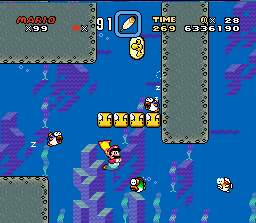
It�s this gap that provides the player with a true intercepts-based situation. While swimming, Mario is engaged in one continuous jump. For this reason, it can be hard to identify a situation where the �term� intercept is meaningful. In dry levels, intercepts are defined by their action of forcing the player to modify Mario�s jump-path, often at the last available moment. If Mario is always jumping while he swims, every enemy becomes an intercept, and so the term doesn�t give us any special insight into a water level. Therefore, in a water level, it�s useful not to redefine �intercept,� but to redefine �jump� for intercepts situations. For the purposes of water levels, almost anything can be a jump, but we can narrow it down here to any situation in which Mario has to accelerate, since this acceleration takes the form of the player rapidly pressing the jump button as well as keeping the directional pad pressed towards safety. Thus, these two little guys are intercepts, because Mario is accelerating towards them to avoid the RVF. Fireballs are an easy solution here, but if Mario isn�t using that powerup, it�s still possible to simply flatten out his path and avoid both enemies. This possibility will disappear in later evolutions.
Next there is an expansion-by-contraction that brings Mario close to combat, although it�s still possible to avoid combat should the player want to choose that path. Indeed, combat is the best solution here, but the low ceiling means that even with fireballs, Mario will have to get in very close to get the right angle to snipe the RVF. Now, if the RVF isn�t engaged and defeated, it will chase Mario into these two syncopated Blurps.

By syncopated I mean any enemies who are parallel and moving at the same speed, but which come at an off-set interval, so that it�s clear that Mario is supposed to sneak between them. (This is something Mario will do frequently in water levels.) Because Blurps are so predictable, the gap isn�t hard to squeeze through, although because of the physics of water levels, having Mario sink to the appropriate height in preparation for that gap is tricky when being chased by a RVF.
The next significant challenge is this one, an evolution/expansion that increases the number of RVFs on screen, and also evolves their situation to surround Mario, making evasion a more complex task.
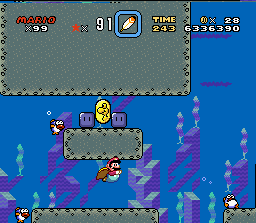
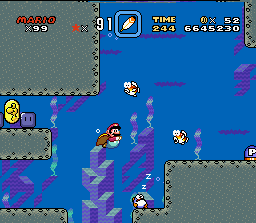
The two patrolling fish aren�t any harder than what�s come before, because although they�re syncopated, it�s only very slightly so. The real problem is that the two RVFs could easily follow Mario into the next challenge. This challenge is a simple expansion-by-contraction of two challenges ago. Instead of two Blurps syncopated at 4 spaces, there are two patrolling fish syncopated two spaces apart. It�s also an evolution because unlike the earlier Blurps, these two are going back in the other direction once they complete their patrol.
Subsequently we have a challenge that is a definite example of the rare de-evolution, but it�s one with an interesting purpose. This Blurp is positioned so that the player either must defeat it by combat (which can be tricky, because the ceiling makes fireballs difficult here) or must quickly discover how low the fatal �bottom� of the level is. Waiting is an option, but waiting is something players tend not to like.
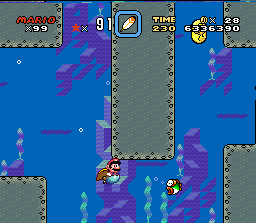
It�s interesting that the designers are able to do so much with just one Blurp positioned correctly, in the correct geography, but it�s a good object lesson. Not all challenges need to increase in difficulty in a linear fashion, or even increase at all. Sometimes there�s a �just right� challenge that can get across a design lesson with a minimum of effort.
The next challenge is a reiteration of the third challenge in this level, with changes so minor that they don�t bear explanation.
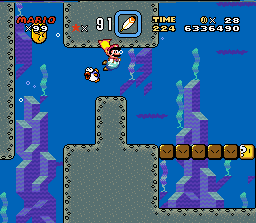
This repetition makes sense only in light of the fact that the player is probably racing forward, trying to get to the hidden key ahead before the P-Block wears off. In that context, a slightly simpler challenge works perfectly because the evolutionary element is present as a global effect.
There are two challenges in the level after this, and one of them is yet another reiteration of the challenge above with changes so minor they don�t bear much mentioning. But before that curiously placed de-evolution challenge is the one below, which is a great example of a non-traditional crossover. In an intercepts-themed level, a crossover challenge is usually a preservation of momentum challenge, but it isn�t so here. Rather, this is clearly a periodic enemies challenge:
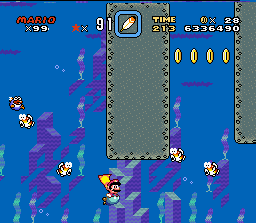
Although this is one of the easier challenges in the level, it is, nevertheless, the first time we�ve seen perpendicular patrols in the water. Essentially, it�s an evolution that leaves out the intercepts that were the foundation of the level so far. Rather than declining across the genre composite, this bridge challenge declines across the stylistic composite. This happens elsewhere in the game�especially in the later levels�but it rarely happens as a bridge challenge. Nevertheless, it works, proving that while there are definitely stylistic guidelines to take away from the study of this game, there are no hard-and-fast rules.
VANILLA DOME 4
Vanilla Dome 4 is the only level in the game to use procedural content in a way that actually develops along the lines of a cadence. The �procedure� in question is the generation of bullets that will make the otherwise simple jumps of this level more difficult. These bullets come in two styles: one or two at a time for the first half of the level, and five at a time in the second half of the level. Without the player trying to make it so, the bullets will never exceed the quantities described above, but as long as Mario is in the proper zone in the level, the bullets will never stop coming. Because of these global intercept effects, the challenges in this level are simple and don�t closely follow the normal pattern of evolution and expansion seen in most levels. There are challenges, and they do change, but any measurements should be taken with a grain of salt, so to speak, because of the high potential for variability. In light of this, most of the things we can learn from this level are about the bullets rather than the jumps, although those are below as well.
The designers programmed the distribution of the bullets across the screen with a specific philosophy in mind. The basic idea behind their design was that the bullets should intercept where Mario is jumping rather than where he is standing. This, of course, reflects the definition of what an intercept is in this game: intercepts don�t cause jumps, but rather modify them. For example, if Mario stands at the zero-height mark for the level, he can wait there for the level timer to wind all the way down without ever being hit. Higher up, that would be impossible.
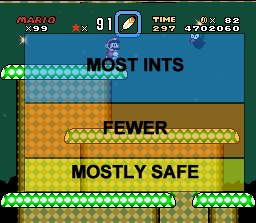
Beyond that, there is no discernible pattern to the way that bullets travel across the screen in the first half of the level. It seems that rather than having to use a different algorithm for each challenge, the designers opted to do the simpler thing and just structure the challenges so that the one algorithm works for several of them. Thus you have these challenges which always provide a safe spot on in the no-bullets zone:
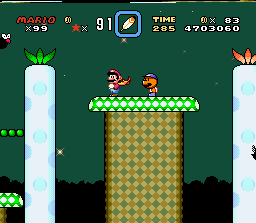
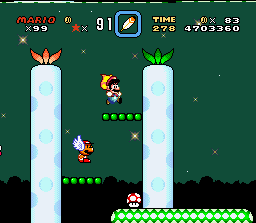
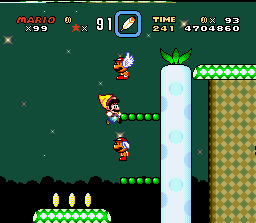
The last one is, obviously, the only evolution/expansion to this point. This level is generally made up of mutations of the same idea�that idea being one Koopa, springboard platforms and a bunch of algorithmically-generated bullets. That right-hand challenge above is a little bit more complex. This challenge also marks the end of the first section.
The second half of the level is itself an evolution, in which the periodic bullets become something more formidable. Rather than one or two bullets flying across the screen, the second half of the level will shoot five of them at a time. More than just being a greater quantity, these bullets will fly in paths perpendicular to one another, creating some dangerous intersections.
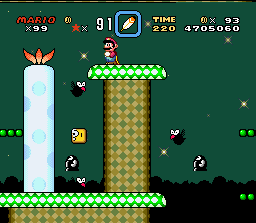
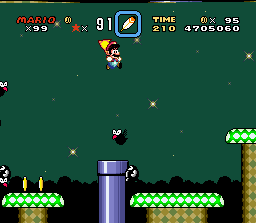
Two things make this challenge much more navigable than it seems at first. The first detail the player should notice is that the bullets always come in the same exact pattern. The second detail to notice is that the bullets only come when Mario stops moving laterally. If Mario remains in the same (laterally measured) two-block space for more than a game-second, the bullets will fire, unless there are still old bullets on screen. This means that this level has introduced a clever crossover challenge that declines toward the preservation of momentum theme. After all, the best way to avoid these bullets is to keep moving, no matter what. The first half of this section obliges this instinct in the player; just look at how flat all those sections are.
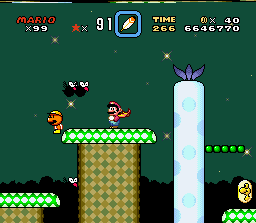
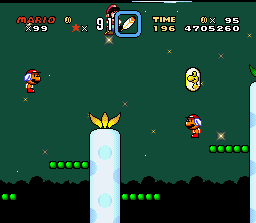
The second section slows Mario down with uneven terrain. Really, this is just bringing back the terrain from the first section of the level, but in the context of the five bullets that fire, it�s an evolution. It�s a great example of how the context of the new bullet pattern basically allows the designers to conserve level design ideas and keep the whole thing tight and coherent.
VANILLA SECRET 2
Vanilla Secret 2 works as an effective counterpart to Vanilla Dome 4, as it tackles the same design ideas in a different way. Vanilla Dome 4 is all about sending a barrage of intercepts at Mario while he is traversing relatively simple terrain. Vanilla Secret 2 does the same thing, but uses a different kind of intercept�and uses it in greater density. The first half of the level is particularly replete, featuring 25 enemies as densely packed as any in the game. For all their dense packing, though, there is a surprising amount of structure and clearly discernible challenges. Moreover, this level shows us some of the nuances of what makes intercepts successful as design features.
An intercept is defined simply as something that modifies Mario�s jumps, rather than something that causes Mario�s jumps. This means that in any of the challenges below, the lead Wing Koopa is the initiating force, and everything else is an intercept that interferes with Mario reaching (brief) safety on the ground before the next challenge. The challenges divide up into bunches of Koopas; these bunches are separated by a geographic feature like the crest of a hill, one or more coin-blocks or both.
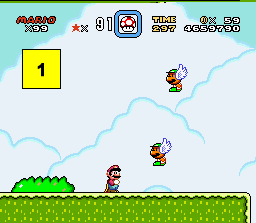
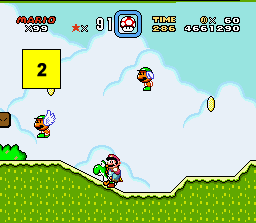
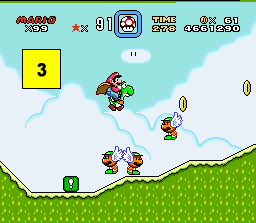
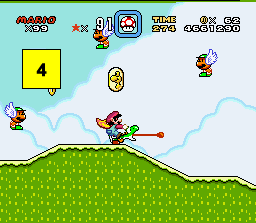
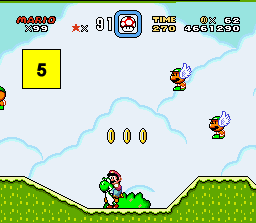


There�s a normal progression going on here, although it is highly condensed. The first challenge (1) is the standard challenge which introduces the basic idea in the level: two Wing Koopas that bounce at different heights. The lead Koopa causes Mario to jump and then have to either bounce consecutively onto the second Koopa or avoid it�but in either case the player will have to steer Mario away from the heterogeneous bounce patterns of the second Koopa. (Obviously, Mario could kill/run past them, but that�s probably not what was intended here.) From there the progression is fairly simple: challenge (2) is an expansion to Koopas that bounce low/high/low. Challenge (3) begins to mix it up; here we have three low-bouncing Koopas. The reason they�re all bouncing low is the terrain: when high-bouncing Wing Koopas come down a slope, it�s very easy to simply walk under them, but low bouncing Koopas are actually harder on an up-slope. (4) On the way down that same slope the player encounters a mutation, where there are three high-bouncing Koopas who are more dangerous because the hill shortens their bounces. The next challenge (5) is a mutation that reverses the standard challenge to lessen the tension before the bigger challenges coming next. Challenge (6) is another expansion; you can see how it actually still uses the same rhythm as the standard challenge (low, high, low, high). Challenge (7) expands the number of koopas and adds one evolution to challenge (6), the coin-block on the left causes the Wing Koopas to turn and backtrack, making the center of this challenge a clustery mess if Mario waits too long to get through it. All in all we have a standard challenge, an expansion, two mutations upon the expansion, a mutation upon the standard challenge, followed by another expansion and finally an evolution. And that�s in a really small geographic space, no less.
The second half of the level is broader but less dense, and contains far fewer challenges of any significance. There are some pipe-dwelling Lakitus and Spiny enemies, although they�re not particularly organized. The reason for this decrease in challenge organization is that this part of the level features algorithmic generation of intercepts, much like Vanilla Dome 4. If Mario stands in one place for more than three in-game seconds, Bob-ombs will parachute down from the top of the screen. The slowness of the parachutes makes these intercepts considerably less fearsome than their counterparts in Vanilla Dome 4, but there is one spot where they can cause trouble. At the end of the level, the final ledge is guarded by a Replicating Chuck. Although this enemy isn�t too tough on its own, three Chucks can slow Mario down enough that the Bob-ombs will start to rain down.
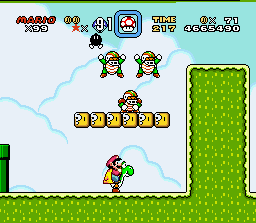
These Bob-ombs, plus the Chucks, plus the Lakitu in the pipe throwing Spiny enemies will quickly add up to quite a crowded house. This is a great example of an intercepts level declining toward the preservation of momentum theme. Sticking around too long for combat will almost certainly do more harm than good for Mario; it�s much better for him to avoid the trap and simply jump and/or bounce his way out quickly.
COOKIE MOUNTAIN
Cookie Mountain is the first real introduction to the second category of intercepts in Super Mario World: the ground-based intercept. The ground-based intercept is similar to the Boo and Rip Van Fish in that it will usually seek Mario out rather than move in a straight line, but it�s also like Bullet Bills and Wing Koopas in that it can�and often should�be defeated by jumping on it. Technically, the player has already seen one kind of ground-based intercept in the Rainbow Shell that begins Donut Plains 4, and the Monty Moles have appeared before, too. This is the first level that uses ground-based intercepts in a thematic way, however, and it serves the purpose of showing new players the enemy behaviors and skills they need to know going forward. The ground-based intercept that this level focuses on is the Monty Mole. The Monty Mole has two particularly important behaviors that the player needs to be aware of.
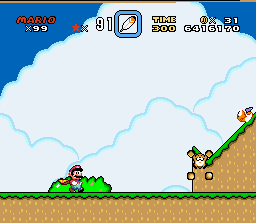
The level immediately makes it clear that the Monty Mole enemy will leap out of the ground to a height of four blocks before seeking out Mario. The problem is that although these enemies are not hard once on the ground, they�re tricky (at least to new players) while they�re launching. The warning shot here fires immediately when the level loads, but other Moles will fire when Mario gets close, making them harder to react to. The sliding, no-shell Koopa causes Mario to jump, but this configuration doesn�t really see development, meaning that this isn�t the standard challenge.
The standard challenge for the level comes immediately after, though: this Monty Mole will leap up from the ground so quickly that it�s very nearly impossible to run past him without taking damage. Mario will need to jump because of the Mole, and herein lies the problem. The Monty Mole isn�t done once he�s out of the ground; the fact that he (and his buddies�he almost always comes in groups) will continue to chase Mario means that Mario�s jump has to be modified. It doesn�t always have to be modified to avoid immediate damage, but it�s going to be a modified downward arc.
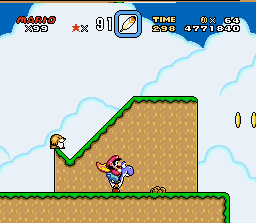
Additionally, because the Monty Mole flashes a warning sign (disturbed earth), the player will likely react by slowing Mario down. This is problematic when the Mole is at or above Mario�s level because if his momentum is lost, jumping over the Moles will be harder. Moles can jump as high as four blocks into the air, and from a standstill it�s not easy to ascend to five blocks in height quickly enough to get on top of the Mole. Thus, the player�s reactions have to either anticipate the Mole�s flight path or aim to leap beyond it. Most of the challenges in this level have to do with making it harder and harder for the player to do just that.
The next challenge is an evolution challenge, but it�s an odd one. In this evolution we meet�for the first time in the game�the Sumo Brother. This enemy, seen only here and in the Special zone, has an ability that makes for some unique situations. The Sumo Brother is capable of making the ground below him catch on fire, radiating out from a center point. That radiating pattern will often make players want to edge forward rather than be overtaken by the fire.

The problem, of course, is that the Sumo Brother is actually part of an evolution challenge, and his ability is chasing Mario toward a Monty Mole who will spring up and deal damage if the player isn�t careful. The jump that starts the event is either Mario�s flight away from the fire, or his ascent to knock out the Sumo by hitting the coin-block; the Mole�s appearance�or even warning sign�modify Mario�s downward arc. It�s odd that the designers would introduce a whole new enemy just to make an evolution challenge, though. It�s even odder that he would only appear in two levels. Whether he was easy to program and animate and the designers simply kept him in there, putting him in two levels alone, I don�t know. He does see more development in this level, however.
The next challenge is a simple challenge that helps to show the player the Monty Mole�s ability to follow Mario�s movements. With the shell located just before it, this challenge isn�t hard by any means, but it does reveal enemy behavior rather clearly.
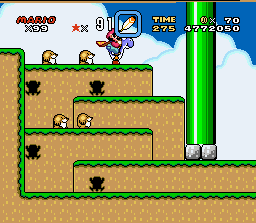
Although the most important property of the Moles is their explosive arrival, their seeking behavior is important as well (and is good training for dealing with Wigglers, later). In close quarters, Moles are quick enough to do damage if the player isn�t paying close attention. The seeking property of the ground intercept is particularly tough in how it makes cape glides more dangerous, as the enemy can easily catch up to Mario during the fall.
After that, we see the real shape of the challenges to come: an evolution/expansion that pits Mario against multiple Moles springing out of different heights and in greater quantities. Not only are the heights different, but the Moles� emergence is also staggered in time so that some will be on the ground and some in the air.
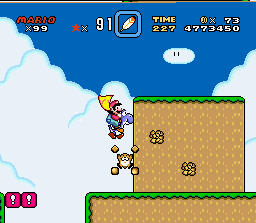
The mixed heights and timings are accentuated by the platform above, which allows the Moles to drop down, potentially onto Mario�s head. The first problem, though, is that the player can only reliably land Mario on the two blocks of space between the bottomless pit and the first Mole. The second problem is having to jump again immediately, and not knowing where to go with all the various Moles coming out. The tracking/seeking property and staggered bursts also wreak havoc during a cape glide that would otherwise be useful here.
Following that, there is an obvious expansion upon the first Sumo Brother challenge, in which there are now two Brothers raining down fire, and a Mole filling the exact same role as before. The music note blocks aren�t a substantive enough change to call this anything except an expansion, although the fact that those blocks are much higher than in the previous challenge of this type is telling.
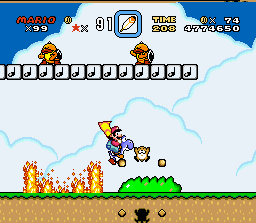
While a higher ceiling does make it harder to attack the Sumo Brothers, it also means it takes longer for their bolt of energy to strike the ground and cause a fire. Knowing how quickly that bolt came down in the last challenge, it seems to make sense that the designers gave the player more breathing room with two Brothers on the screen at once.
After this there is one of the game�s most obvious expansions: the Moles spring from the cliffside much as before, but in obviously greater quantity.
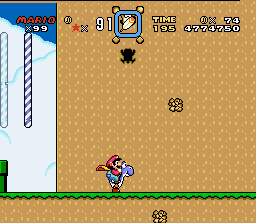
If anything, this also constitutes a de-evolution, because there aren�t any platforms overhead for the Moles to run along, meaning that they�ll always land right below their pop-out points. After this is another relatively straightforward challenge.

This is a good example of a mutation upon the first cliff full of staggered Moles: it reconfigures the Monty Mole population differently, although not more complexly or in any greater number. By that same token, it doesn�t do much that warrants further explanation.
The end of the level has a couple of slightly bizarre�although not necessarily bad�design choices. The first one is the roulette block. Most of the time, when the roulette block appears, it�s followed by a dense gauntlet of enemies, so it�s clear that the point of the roulette block was to give the player a Super Star (as long as the player could pull off the grab). This Roulette Block is followed by a grand total of three enemies, so there are exceptions to every trend. Irrespective of powerups from that block, this challenge is unusual. Here the designers have created an evolution of an evolution�but have removed the standard challenge element from it.
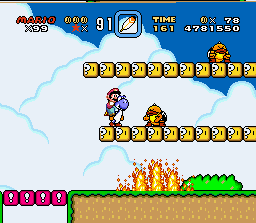
Up until this point in the level, the Sumo Brothers have always interacted in a meaningful way with the Monty Moles that accompany them. This time there are no Moles, but there is an evolution that stacks the brothers on top of one another. This kind of evolution doesn�t happen very often, nor are there many levels with two �competing� standard challenges, although both of those things do happen elsewhere. The Sumo Brother seems like it was a design idea for which the developers had plans but no time or resources and the unusual break in style here is a function of practical problems. They simply wanted to use this enemy again, because they had it. This, of course, is pure conjecture, but the challenge works well enough that I can�t fault it.
BUTTER BRIDGE 2
Butter Bridge 2 is a level that feels big, open and chaotic, but which is actually surprisingly organized. Much of the feeling of freedom comes from the fact that the level is very flat and so offers the player some opportunities to soar up into the sky. Interestingly enough, this is inadvisable because of how many intercepts wait below. Unless the player can sustain flight for the whole level (a technique that will break almost any level in the game), the descent could be very dangerous. Although this is probably just serendipity, it�s nice to see that there were levels which offered some unexpected peril to players using sustained flight.
If the player isn't constantly soaring up and down with the cape, he or she will actually encounter one of the most neatly organized levels in the entire game. In fact, this level is so well organized that it could be used as a model for teaching the Nintendo style of design. It has all of the classic features, beginning with a clear warning shot and a series of encounters with the standard challenge, shown on the left below.
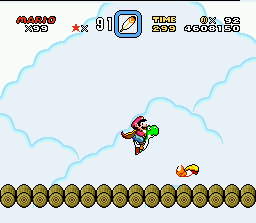
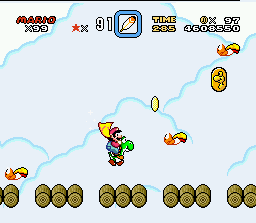
The standard challenge gives way to these small evolution/expansions pretty quickly. The goal of this challenge is to prepare the player for the speed and arc of the Super Koopa. Although this level is brimming with them, the Super Koopa isn't a terribly common enemy in the rest of the game. Moreover, this enemy travels at a speed not shared with many other intercepts (about halfway between a projectile and a Wing Koopa).
The evolutions start to come once the gaps in the bridge close up and the player faces one long section filled with intercepts. The first thing the player encounters is the "B" section that will become part of the many A+B evolutions to come. From there, it's not hard to spot the evolutions and expansions that follow. The number of kicked Koopa Shells go up, as does the number of swooping Super Koopas.
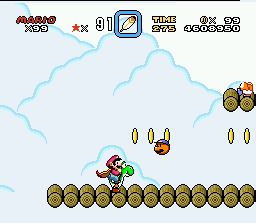
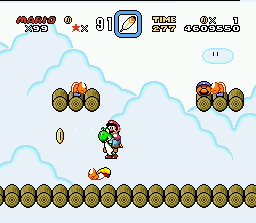
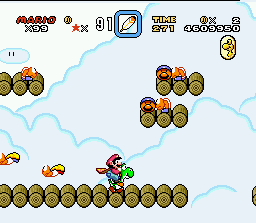
What you see above is the hallmark of the second half of the intercepts them: it�s all about mixing types of intercepts. When intercepts are mixed, the player has to choose (very quickly) which enemy is Mario's first target, and which enemy then becomes the modifying intercept; sometimes this choice is ambiguous This adds a cognitive layer to an otherwise twitchy reaction skill. The obvious mix is the A+B evolution in which the player has to react to both a kicked shell and a Super Koopa, on the left, above. This is succeeded, however, by an A+B+C evolution, in which another Super Koopa with a red cape launches from the ground with an entirely different arc, adding yet another intercept with a different flight path to the challenge.
(Note that the Super Koopas will start coming down all over this zone on a timer-based algorithm, so the exact number can be confusing. With that in mind, there are also deliberately-placed enemies that do not run on an algorithm, and it is based on these that the challenges are divided.)
The second section of this level moves away from mixing enemy types and instead throws various configurations of Super Koopas, in different shapes and quantities, at Mario. This section of the level is also filled with algorithmically generated Super Koopas, who will emerge from both edges of the screen and fly toward Mario. The pattern of those Super Koopas is only meaningful in that they make everything else an intercept; if Mario is always jumping and avoiding, the player always has to modify Mario's flight path whenever something else comes on screen. What makes the section really work, though, is that layered on top of this procedural barrage are the hand-touched challenges that cause the player to use a variety of skills. The first such challenge is this wall of intercepts.
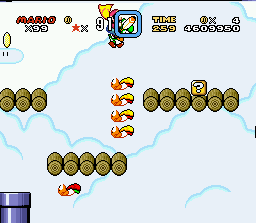
Although Super Koopas come in stacks in every level they're in, they're never this tightly packed. This density serves to make the stack shorter, but it also prevents Mario from having any useful action solutions. The best a player can do is to defeat one or two of these Koopas as they swoop down, and the remaining Koopas will probably damage him. Jumping over the stack is probably a better idea, and it's certainly easy to do if Mario is on that upper platform (above, left). From the bottom platform, it's much harder. The designers were trying, it seems, to incentivize Mario to be on that lower platform with the pipes�but it's a weak incentive. Levels without secret exits don't lure players into secret pipes; Yoshi coins simply aren't that enticing except to the most ardent completionists. (This is another problem which Yoshi's Island solves wonderfully.)
The next set of challenges is far more effective because Mario has no alternatives. Here, two Super Koopas fly down, leaving Mario a gap between them to jump through. Mario must jump, but the enemy that causes the jump isn�t the only concern. The upper Koopa is too high for an easy kill, so threading the gap makes the most sense.
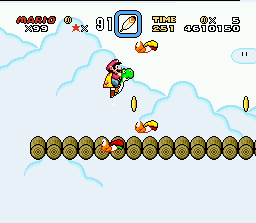
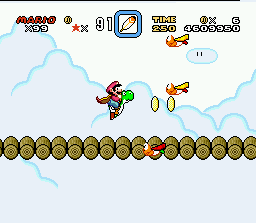
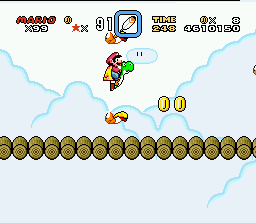
Following that is an expansion-by-contraction that is textbook in its technique, but a little inconsistent in style. The gap between the Koopas narrows, and the player's best bet is to have Mario execute a controlled-height jump. The problem is that the controlled-height jump is not something common to this skill theme, and is not a skill that the player has had to use much of by this point in the game. The action solutions to this problem (killing one of the Koopas) are not much easier, because of how each of these challenges arrives just on the heels of the other one while the algorithm continues to spawn Super Koopas.
In the end, the overall structure of the level takes the player from the �here comes a speeding enemy� set of challenges to a �how am I going to thread this gap� set of challenges. The former is based on reacting as quickly as possible to get airborne (or run forward and duck, alternatively) and away from enemies, while the second is about moving towards those enemies in order to get the best position between them. Both involve lots of mid-air adjustments and quick movements, and so they�re both clearly intercept situations. That these two related experiences are so different, even within the context of a single level, is remarkable and a testament to the depth of the style the Super Mario World design team was using.
FOREST OF ILLUSION 1
Forest of Illusion 1 begins to mix ground-based intercepts with enemies of other kinds. Whether it's the Super Koopa, Volcano Lotus or Hammer Brother, intercepts have tended to fill the air. In Cookie Mountain, the game started showing the player the ways in which ground-based enemies can be intercepts, too, but the Monty Mole also has an aerial component. Like the rare rainbow-shell and the slightly more common Monty Mole, the Wiggler will follow Mario and thus become an intercept, especially in the presence of other enemies that slow Mario down.
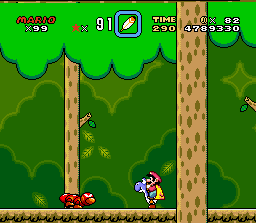
After taking jump damage, the Wiggler will speed up rather than dying, and will chase Mario more aggressively. The lone Wiggler shown above is the standard challenge, and isn't really an intercept because it's so easy to avoid. This will change with evolutions.
The first evolution of the standard challenge adds other types of enemies. These Goombas don't leave useful Koopa shells, and so won't give Mario any way to defeat the nearby Wiggler--meaning that Mario will have to steer around it if he's not using Yoshi.
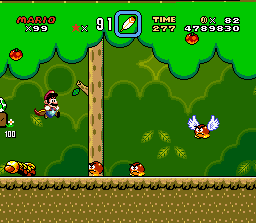
The second and third evolutions are different in a meaningful way. Typically, a sequence of evolution challenges will increase the complexity of the standard challenge in a linear fashion. Element B is added to A, then C added to the sum of A and B. In this level, we see three different evolutions upon the standard that arrive at different places. After the first evolution mixes in Goombas, the other two evolutions add elements so different that they can't be called mutations, for the complete lack of parity they have with each other.
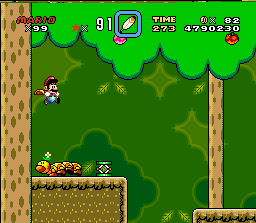
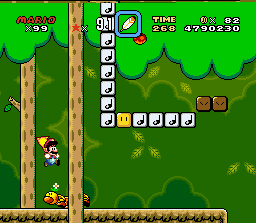
The springboard is complicated by the fact that if Mario doesn't launch quickly, the Wiggler with its odd hitbox and bounce properties can interrupt Mario's attempt. The third evolution adds a ceiling above the Wiggler and the chance for a 1-up if Mario can use the note-blocks the right way while avoiding the Wiggler. All of these challenges are clearly evolutions that increase the complexity of the standard challenge, but they're so different from one another that they can't be called mutations of each other.
After a simple expansion, the challenges in this level begin to grow in size and complexity, building off the second challenge's combination of a Wiggler and other mixed enemies. The simple expansion that comes first is interesting in that simply by adding more Wigglers, it gains hints of the preservation of momentum theme.

Three damaged Wigglers will make for an unsafe platform, necessitating Mario's quick exit. By that same token, the jump attacks which make Wigglers dangerous also allows the player to chain together several jumps while preserving Mario's momentum. Hints of the preservation of momentum theme continue in the next few evolution challenges. There are two long challenges that evolve the level's first evolution again. Both sections combine ground intercepts with air intercepts, by having ground-based enemies drop out of the sky.

The buildup of enemies on the ground, including Wigglers, puts Mario in a situation where he needs to either keep enemy-bouncing, or go all-out with combat techniques like using Yoshi and/or the Koopa shells available. The falling enemies add another layer of intercepts to the mix in both locations, often staggered in close proximity to one another so as to intercept Mario�s downward arc. The terraced structure of the second long challenge (below) complicates this even more, by contracting the area that Mario has available for dodging.
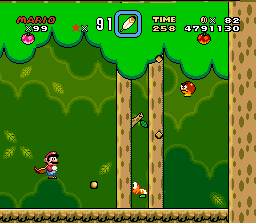
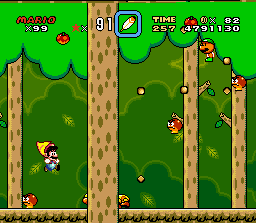
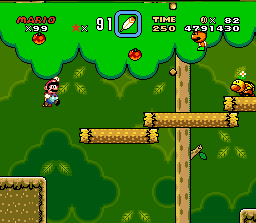
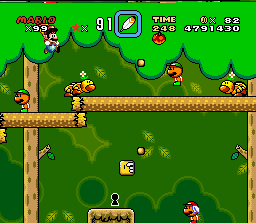
Both of these are sections full of mixed intercepts, a trend that becomes more frequent after this level. (Although both these sections become one epic preservation of momentum challenge if the player gets the Super Star from the slot block before it.) After those two long challenges, the final evolution in the level is really rather standard. As many levels in the preservation of momentum or intercepts themes have done, this one ends with a Flying Hammer Brother. This time though, he is the B portion of an A+B evolution that includes the Wiggler.
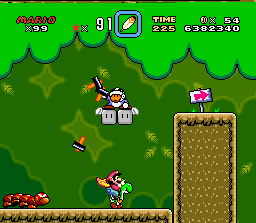
What the designers were probably aiming for here is either to get Mario bouncing off the Wiggler into the Hammer Brother's platform, or to make the player use the additional height of an enemy-bounce off the Wiggler to get over the right-hand wall. While this serves well as a pinnacle challenge for the level, it doesn't actually build on the two previous evolutions; rather, it goes back and builds on the second challenge in the level. If every evolution challenge in a level were another step up the chain of complexity, levels would become too challenging and needlessly cluttered. In this challenge, the designers show us how to create a good, sufficiently climactic challenge without having to throw everything and the kitchen sink into it.
FOREST OF ILLUSION 3
Forest of Illusion 3 is the purest example of the intercepts theme, and yet it doesn't feel like most intercepts-themed levels. The reason for this is that in stripping away everything that isn't an intercept, the level takes away the defining experience of the intercepts theme. The intercepts theme is about obstacles which complicate jumps; this level is full of that, but everything else typical to an intercepts level (like jump-causing regular enemies) is removed. In the entire level, there is only one enemy that behaves like a normal enemy, while everything else behaves like an intercept. The cause of all this is a bubble.
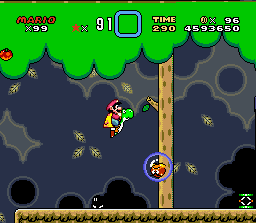
When it collides with any object, this bubble will burst and drop an enemy out of the sky and possibly onto Mario. The problem with this is that instead of looking at the platforms ahead, the player is going to have to spend all of his/her attention on looking at what's above Mario, to make sure that there won't suddenly be a Bob-omb or Goomba falling from a coin-block. The constant threat of possible falling objects and extra attention paid to the sky necessitates the removal of anything ground-based. Thus, the designers left out things like Wigglers and Koopas.
That's only half the story, though; the other half is that one of the objects a bubble can collide with is Mario, and when this happens, it's a problem. Bubbles have a singular property: they really screw up Mario's momentum. When taking enemy damage in flight, Mario does usually lose some momentum, but the effect is enhanced when he collides with a bubble. After hitting a bubble, Mario tends to drop like a rock, at least for a second, before the player can cape-glide again. To make this effect more meaningful in gameplay, the bubbles are frequently positioned to intercept Mario's jump-path where it would cause him to take damage or die.
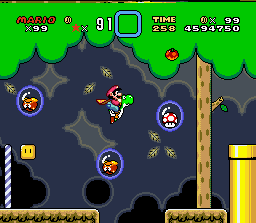
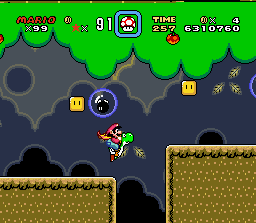
The bubble containing the Mushroom pictured here doesn't cause damage by itself, but it can drop Mario straight into the pitfall below. In the second case, on the right, Mario's jump is delayed to the very edge of the pit because of the cluster of bubbles which would hurt and possibly kill him. The entire level is rife with this.
Because of the free-floating nature of these bubbles, there aren't strictly localized evolutions, although there are more wide-ranging evolutions and plenty of expansions. The expansions are somewhat obvious; the number of bubbles gradually increases across the early challenges of the level. The evolutions are a little vaguer, although they're present, too. What evolves is the aerial terrain, rather than the enemies that occupy it.
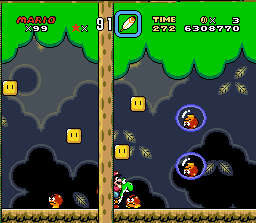
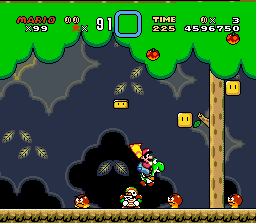
The level progresses from a fairly typical pipe geography to a scattering of overhead blocks which pop the enemy bubbles, and then from there to a much thicker scattering of overhead blocks, and finally to a scattering of blocks with a Charging Chuck thrown in. There aren't really "point" evolutions, but the overall trend is clear. Throughout the level, the player will constantly have to react to unusual enemy patterns and take modified jump-paths because of the clouds of bubbles. The designers set out to create an environment where every situation called only for the player's intercept-specific skills, and they accomplished just that.
THE GHOST HOUSES
We�re going to look at all of the ghost houses at once. One reason is that it�s probably best to ignore the puzzles and secrets, as there isn�t really a repeatable lesson to be learned from them. Almost all of the puzzles are simple things that become uninteresting immediately after the player figures them out. Zelda titles are the place to go if you want to study Nintendo�s puzzles in a meaningful way. The reason for doing all the Ghost Houses in one shot is that these levels feature very few challenges per level, and those that they do feature are so close to one another that there�s hardly any point in separating them. Challenges in one Ghost House tend to act like evolutions upon challenges in some house earlier in the game, rather than evolutions within the progression of the level itself. For example, this challenge is from Vanilla Dome, and it uses the ghosts� mechanics nicely:
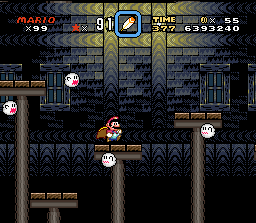
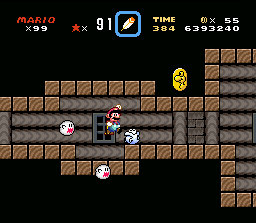
On the left you can see how this setup makes the scattered Boos into a meaningful challenge. As the Boos close in on Mario the player can jump around the various platforms to evade. This will also show the player the hidden property of the Boos: they don�t fly straight at Mario, but rather will pull up a bit, often placing themselves in his jump-path. (Without that property, the Boos would be rather boring, at least from a design point of view.) The Forest Ghost House evolves this by putting a ceiling on it, and uses an expansion-by-contraction by narrowing the field and adding an Eerie. In Vanilla Ghost House, it�s easy to take advantage of the staggered platforms because there are many of them and Mario can jump through the floors when ascending. In Forest Ghost House, the player faces a more difficult version of those circumstances.
While it takes until the Vanilla Dome for the designers to create a challenge that really exposes the Boos� behavior, the Big Boo gets a more effective introduction. In Donut Secret Ghost House, this challenge does a lot to teach the player how to handle Big Boos, and by extension, Boos in general:
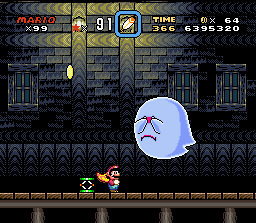
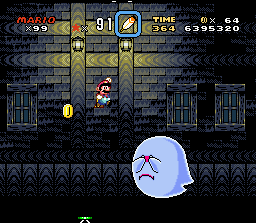
Here, the springboard clues the player in to the notion that they need to draw the Big Boo down to a height where the springboard�s additional momentum will be enough to clear him. The important part of this is that the player is instantly going to recognize the strategy because even the newest players will know what a springboard does. Thus, the deduction that the Big Boo�s height needs to be drawn down is easy enough, and it will reveal this essential behavior. That said, I don�t think the exposure to Big Boos that begins in this level adequately prepares the player for the Big Boo boss, who behaves differently enough that new players might be confounded. Throughout the first few ghost houses, it seems like the designers categorically treated Boos as though the player would already remember how to deal with them from SMB3. Although they are a simple class of enemy, I don�t think this was necessarily a wise philosophy.
The enemies in ghost houses are almost all intercepts, and while the Boos are not always very interesting intercepts, many of the other enemies are. The Eerie enemy sees the most development of any enemy in the ghost houses, and they accomplish the inherent goals of the intercepts theme most adeptly. The Eerie is a fast enemy; its speed is exactly calibrated so that it�s not that dangerous if Mario is walking or stopped, but it becomes a real challenge to a new player�s reflexes if Mario is running at full momentum. What makes the Eerie interesting from a design point of view, however, is its variety of movement patterns. In its most evolved state, the Eerie makes for the content of a whole section of level:

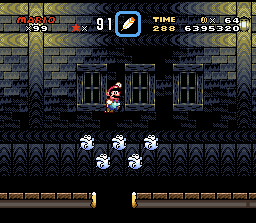
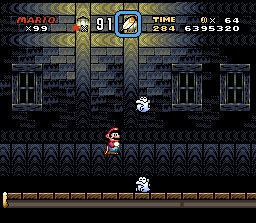
Here, the Eeries are configured so as to really force the player to minutely alter the shape of Mario�s jumps, a degree of subtlety that will be essential in the later part of the game. In each case, the Eerie isn�t necessarily the cause of the jump�although that can vary�but rather just the factor that shapes the jump once it is begun. Thanks to the Fishin� Boo (an evolved form of the Fishin Lakitu from Forest of Illusion 4), these challenges manage to emphasize the controlled-height jump in a way that the player will clearly pick up on.
The Fishin� Boo isn�t the only instance of a Ghost enemy acting as an evolution of an enemy first found outside a ghost house; in two ghost house levels (Vanilla Ghost, Valley Ghost) there is the anonymous green glob, which is a rather sly evolution of an enemy one might not expect. It�s actually a kind of mid-range enemy that has a flight path splitting the difference between Swoopers and Super Koopas.
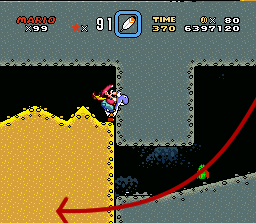
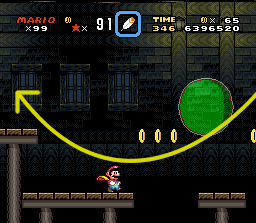
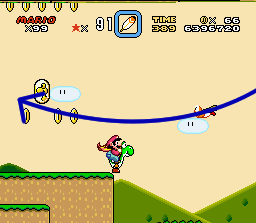
The flight path of the green glob, Super Koopa and Swooper are decidedly similar; so much so that they will usually elicit similar strategies from the player in the form of cape-glides, back-jumps and cut-jumps. One could argue that the green globs are part of the same idea as the swooping swarm of ghosts in the second section of Forest Ghost House or the beginning of Donut Ghost House, but those only look similar and have a similar setting�they don�t require similar skill sets.
It seems that the mission of the Ghost Houses was to intersperse short, puzzle-oriented levels into the course of the game, and they have obviously succeeded at doing that. The puzzles, especially the final puzzle in Valley of Bowser, are not terrible. But while much of what goes on in this game can be translated to other games, and perhaps even to games that haven�t been made, the puzzles in the Ghost Houses don�t really reveal an interesting intersection between mechanics, or a consistent and exportable strategy. For those reasons, studying them wouldn�t enrich our understanding of this game more than a simple FAQ or walkthrough would.
CHOCOLATE ISLAND 1
Chocolate Island 1 introduces the Dino Rhino and the Dino Torch, which is an evolved ground-based intercept. In fact, the level does little else than introduce this enemy, because of how dynamic it can be in the right situation. The Dino Rhino and its little version, the Dino Torch, include the accumulated properties of numerous enemies up to this point. Like the Rex, they (or at least the big ones) take two hits to defeat. Like the Wing Goomba, they bounce/leap. Like the Wiggler and Monty Mole, they follow Mario across the map. Unlike any other enemy, they will jump over obstacles three blocks in height or less to follow and/or surprise a waiting Mario. Lastly, the little one breathes fire.
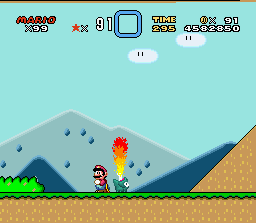
Because of all these properties, the Dino is the level's only real feature; except for one spot in the middle, all the challenges are just changes in the shape of the terrain. But, these properties are enough, especially within this skill theme. The novel, ranging behaviors of the Dinos make for a lot of instances where the player will have to suddenly turn, jump or glide in a new direction. That's what the intercept theme is about, and these enemies do a very good job of making that kind of player behavior happen by themselves.
In addition to the fact that everything in the level is built around one enemy, or perhaps because of that fact, the challenge structure is a little unusual. This level is best understood as two standard challenges, one being a set of slanted platforms with Dinos on it, and one being a shaped valley with several more of them in it.
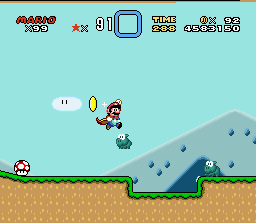
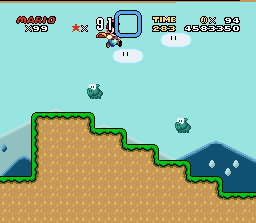
Both of these see iteration: the valley geography mutates (being neither harder nor easier, just a little bit different, qualitatively) and the number of Dinos goes up. What's odd about this is that the number of Dinos goes all the way up to its maximum (4) in the level immediately, rather than slowly building across multiple challenges.
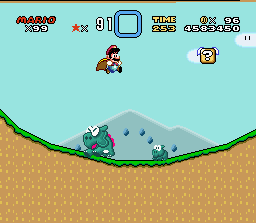
The later mutation which changes the shape of the valley keeps the same number of enemies. The sudden surge of enemies and lack of meaningful fluctuation within this progression is unusual. But, then again, this level is all about exposing the player to this enemy in large numbers so that the crowded terrain forces the player to intercept-style reactions and redirections.
The pinnacle of the level is another terrain evolution. This time, the relatively smooth valleys are replaced by this section of pipe-enclosed ditches which make it harder to avoid the enemies. Because the pipes make it so that Mario must jump, the player will feel the intercept quality of the enemies here the most vividly.
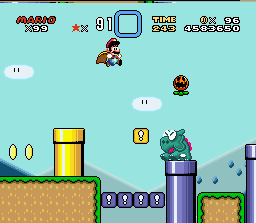
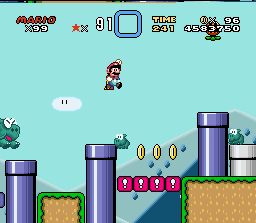
Between the many Dinos that jump over the pipes (effectively increasing the pipes� height) and follow Mario as he moves through the challenge, and the Pumpkins that also leap up, this is a fairly dense challenge. With the switch palaces, the penalty is low, but the challenge is so long that Mario can easily take damage twice and die just from the enemies. This is probably the best evidence for the player�s awareness of the increasing threat of intercepts as they accumulate at the end of this theme.
STAR WORLD 2
Like many of the other levels in the Star Road and Special zones, Star World 2 does something a little bit weird. In this case, the weirdness is simplicity in a game that rarely does anything simple. This level is simply a �gonzo� water level, featuring no special terrain and only fish-type enemies. There are some expansions at work, as you can see the gaps between groups of fish drop.
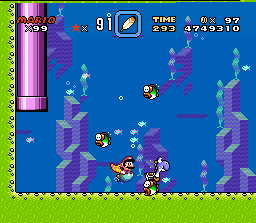
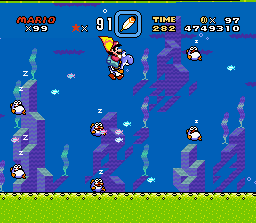
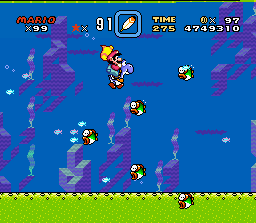
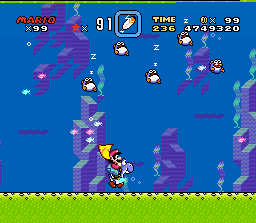
It�s basically two kinds of intercepts (seeking, linear) that mutate a few different ways. The numbers change a little, but the trend isn�t progressive. Except for the second spear of Blurps, none of these waves can properly be called expansions. We also can�t call them evolutions because nothing new is added, and there�s never an A/B mashup. The shapes and positions of the fish do change, though, so it does make for different, mutated views of the same challenge.
The only other design feature of note is one only found one time elsewhere: if the player is able to make it to the first coin-block while still under the effects of the star powerup, this block will issue a second star. This conditional mechanic is only featured in one other level�that being Donut Secret 2. That said, this mechanic is used numberous times in Yoshi�s Island, in the Baby-Mario version of the star. Perhaps these two levels were the genesis of that idea.
SUNKEN GHOST SHIP
Although this level is short and does not have a real design cadence, it nevertheless reveals some useful techniques. The free-fall section is a quintessential example of reward-by-fun, executed perfectly. There�s actually not much to say about it other than that the combination of a Super Star and the uncertainty below makes for just the right (that is, very slight but still extant) amount of tension for a reward-by-fun. The two sections before the free-fall have a lot more to teach us. This pop-in cloud of Boos seems dangerous, but isn�t for an important reason.

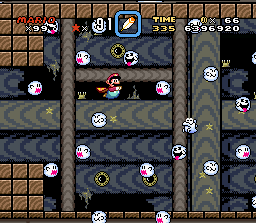
Although the cloud of Boos comes on suddenly and fills most of the screen, it is not dangerous because the Boos have been modified: their hitboxes are smaller. In the image above and left, Mario is not in the act of taking damage; he can pass through the outer portions of the Boos without any trouble. The center of any given Boo will still damage him, but the �soft� hitbox means that the player can react to the appearance of the ghosts and steer elsewhere in the water. This, of course, is the kind of reaction-based situation that indicates the presence of intercepts. These intercepts don�t behave like the other intercepts in the game, but that is what makes them noteworthy. It�s almost a shame this section doesn�t see more development in a short cadence. Above (right) it�s obvious how the designers might have done it, by adding undulating enemies like the Eerie, but one evolution is all that occurs. The goal here seems to have been an interesting introduction to a symbolically important reward-by-fun section. Too much length will kill a reward-by-fun, and so we see one of the many places in which designers have to compromise an interesting but untested idea for a structure they knew was going to work.
VALLEY OF BOWSER 2 (FIRST SECTION)
Although the largest section of this level is in the periodic enemies theme, the first section features a developed cadence in the intercepts theme. This cadence is a bit short (although rather dense), but it does develop clearly and with all the normal features of a typical theme. It also features some unique intercept combinations, as it brings back the disused Swooper. The standard challenge sets up an undulating platform that carries Mario over an un-jumpable wall. When Mario rides the platform to its apex, a Swooper flies from an invisible position above the screen and cuts across Mario�s path. Specifically, that path cuts off Mario�s ability to jump from wall to wall, avoiding the undulating platform in the middle.
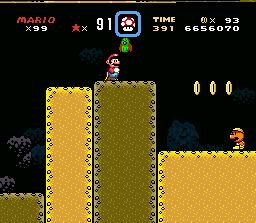
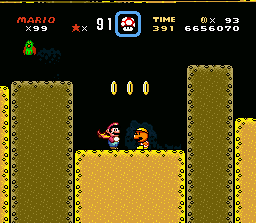
This Swooper/platform combo evolves quickly across the cadence, combining with various other enemies. The first instance is a simple evolution that adds a patrolling Koopa for the next undulating platform, with another invisible Swooper waiting for Mario above the platform to the right. The next challenge is a relatively drastic evolution/expansion. Here there are now three enemies, two of them definitely intercepts, and two platforms.
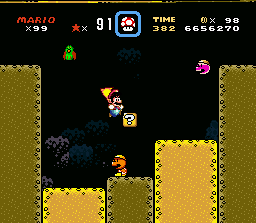
The Swooper also moves from the normal position atop the platform, instead appearing in the middle of the challenge. The point of this is to prevent Mario from just gliding across the gap, as his path will be cut off by the Swooper�s arc. This means a lot, since that rainbow shell makes getting through the valley between platforms hazardous. The rainbow shell is a moderately dangerous enemy, but when it�s coming at Mario from above or in a confined space, its danger is enhanced considerably. Both of those things are true here, making this the clear climax of the cadence.
After this, the challenges actually devolve a bit, although they�re still more complex than the standard challenge.
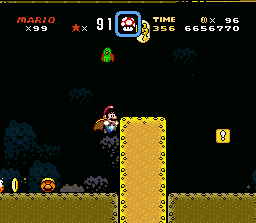
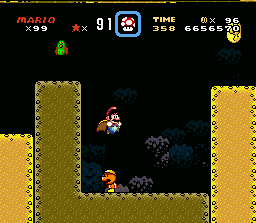
There are several Koopas to deal with, but the Swooper is still the most dangerous element. Although it�s not in the most typical structure, this section features a clear and fully developed cadence which makes a long level that much longer. If the section that came after it weren�t so bad, this would be a much more memorable level for having sections in different themes.
OUTRAGEOUS
Outrageous is the climax of the intercepts theme, and it delivers on its climactic potential far more directly than the other pinnacle challenges in the game, while at the same time doing something totally brilliant and unique. The general structure of Outrageous is to simply take every kind of intercept in the game and combine them in various ways. As the various intercepts start to overlap, their combined behaviors make for some very tricky challenges. Now, because there are so many different kinds of intercepts, it would be impossible (from both a design and technical perspective) to get them all into one challenge, although several places in this level come close. In order to do as much as possible, this level has one cadence embedded inside another cadence, something which really isn�t done anywhere else in this game, or any other Mario games that spring to mind.
The level begins simply enough, by showing a standard challenge of one ground-based intercept, the Wiggler. To this it adds the new and unique-to-this-level enemy, the Bound Fire in a simple A + B evolution.
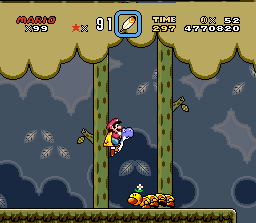
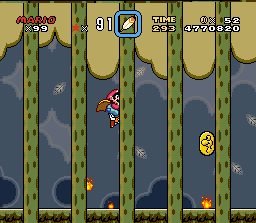
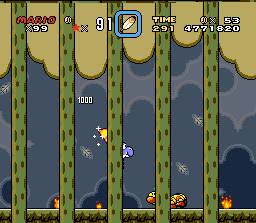
Although the enemies are clearly both ground-based intercepts, their behavior is different enough that the combination is complex. The Bound Fires move periodically, with a �hopping� motion that takes them above ground height, and they leave flames in their wake. Although it�s possible to defeat the flames in combat, they�re small enough that it isn�t easy, especially when there are other intercepts around. One thing this challenge teaches the player is how to �surf� the Wiggler to stay extra mobile and out of low-lying danger. Those two challenges represent the standard challenge and its first evolution.
This brings us to the cadence-within-a-cadence. The section pictured below is defined by the cannons which shoot Bullet Bills. If you haven't skipped ahead to the analysis of this level, you will probably recognize the cadence which this section forms.
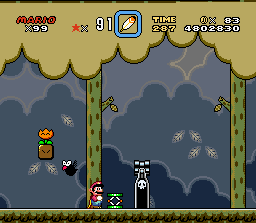
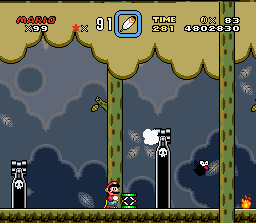

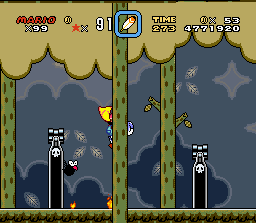
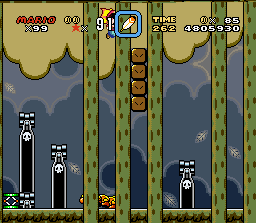
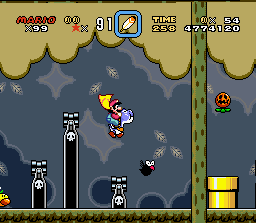
What you see here is a new standard challenge (the single Bullet Bill launcher), followed by a series of expansions and evolutions. Each expansion or evolution is demarcated by the presence of one higher-than-average turret or other obstacle which prevent Mario from easily gliding from turret to turret. The pattern seems clear but is actually deceptive; a cursory glance reveals one evolution or mutation after another as each box/valley rotates a new enemy or terrain in. But take careful note that the number of guns actually goes up too. In challenge 1 there's only one gun, but for every challenge after there are guns both behind and in front of Mario, and they are equally dangerous regardless of position. This is one of the few instances in the game of enemies still being dangerous once they're nearly off the screen. What�s more, the guns don't fire at once or at obvious intervals, so there's almost no way for the player to simply "figure out" the pattern and focus on something else. Indeed, because Mario has to carry the springboard through several challenges, the player has to focus on that puzzle instead. This is the intercepts theme at its most idiosyncratic. Intercepts are what happen when the player is trying to focus on something else and has to react. To create the pinnacle challenge for this theme, this embedded cadence pulls together every kind of intercept and then makes Mario extra vulnerable with the tall towers that slow down his movement and necessitate the carrying of the springboard.
Now, the reason we can say that the Bullet Bill section truly is an embedded cadence is that, after the shooting stops, the level resumes almost as if it had never started. Most of the guns start disappearing, and the level starts sequentially introducing various kinds of intercepts before accumulating them again. The level begins by introducing the Hammer Brother and breakout/drop intercepts.
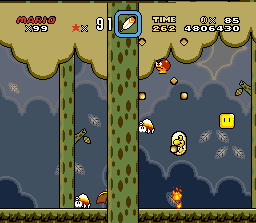
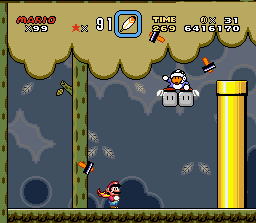
This all builds to an obvious second pinnacle that combines as many kinds of intercepts as will fit in the level for technical reasons.
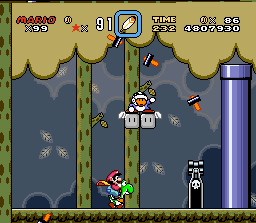
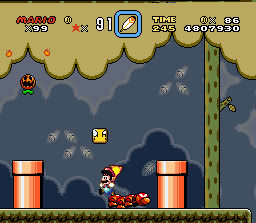
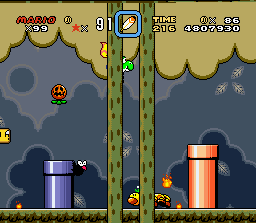
Each image above shows some kind of accumulation involving Hammer Bros, Bullets, Wigglers and Bound Flames, with all of them (except the flames) coming together in a rather cramped pinnacle challenge. Now, while that island is cramped, it�s still easier to jump out of than the earlier embedded climax, so I would deem this a slightly lesser�but still definitive�second climax for the level.
What�s amazing about this level is how oddly structured it is, yet how well this odd structure works. The embedded cadence isn�t merely a digression, it�s the climax of the level�and yet it comes well before the geographic mid-point of the level! It�s a rare structure in game design. There are two pinnacle challenges, both built out of an accumulation strategy that makes this level difficult but fair. Nothing appears in the level which isn�t totally normal for the theme, and both pinnacle challenges only contain ingredients found earlier in the level. Within the framework that Super Mario World has set up, this is great artistry.